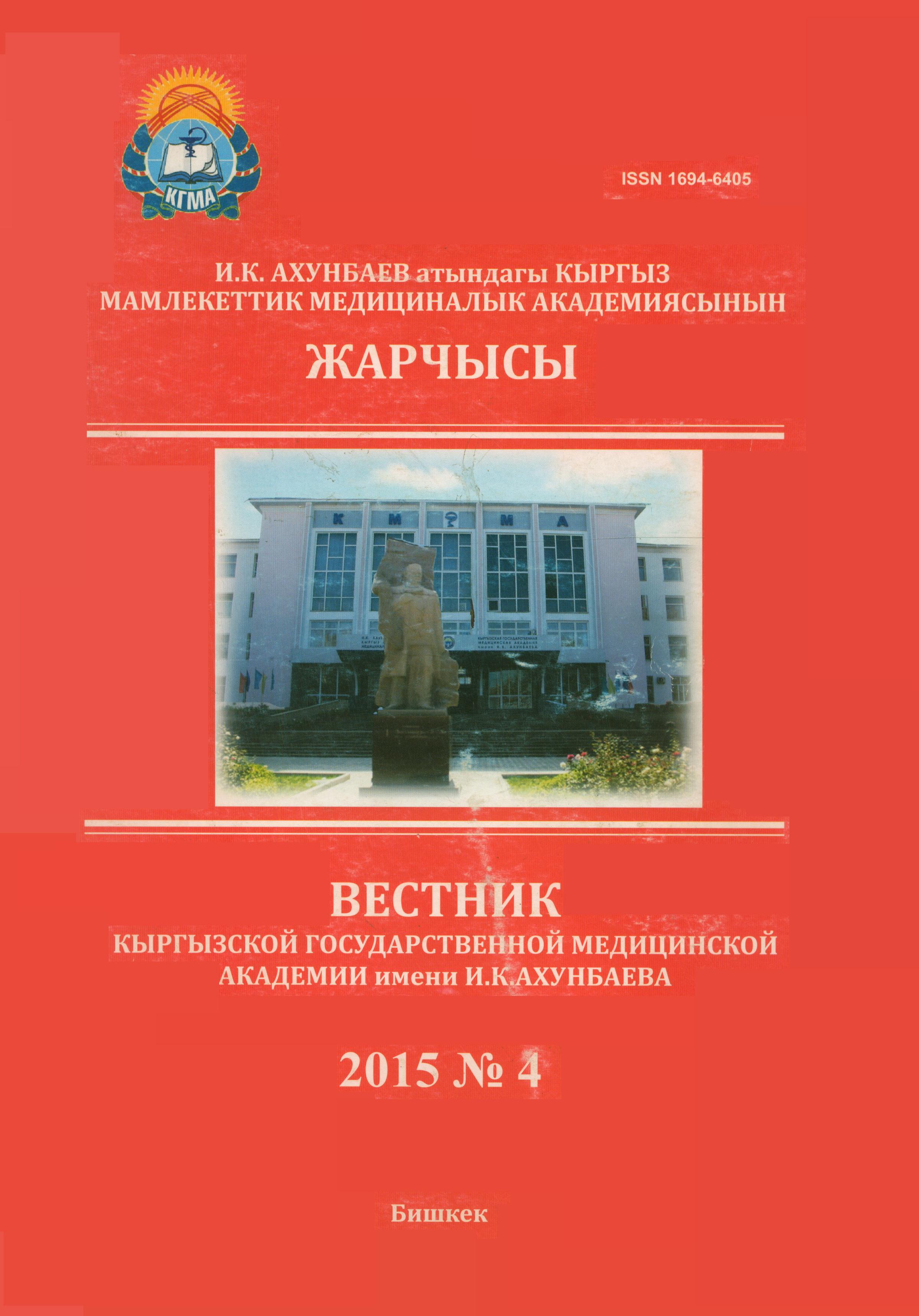КОНТРАСТ-ИНДУЦИРОВАННОЕ ОСТРОЕ ПОВРЕЖДЕНИЕ ПОЧЕК. ФАКТОРЫ РИСКА. ЛИТЕРАТУРНЫЙ ОБЗОР
Аннотация
Современная медицина широко использует разнообразные лечебно-диагностические процедуры с использованием рентгеноконтрастных средств. В связи с чем появилась проблема развития рентгеноконтрастной нефропатии. Рядом авторов выделяется несколько факторов риска, таких как возраст пациента, сопутствующий сахарный диабет, анемия, исходная почечная недостаточность и др. Но несмотря на большое количество клинических исследований, многие вопросы контраст-индуцированной нефропатии до настоящего момента остаются не вполне ясными, что приводит к необходимости дальнейших исследований в этой области.
Ключевые слова:
контраст-индуцированная нефропатия, контрастные вещества, ХБП, сахарный диабетБиблиографические ссылки
1. Миронова О.Ю. Индуцированная контрастными веществами нефропатия. Тер.архив 2013; том 85. №6: стр. 90-95.
2. Шульженко Л.В., Першуков И.В., Батыралиев Т.А. Контраст-индуцированная нефропатия. Фокус напрофилактику. Интервенц. Кард. 2010; 20: 47-59.
3. Ahuja TS, Niaz N, Agraharkar M. Contrast-inducednephrotoxicity in renal allograft recipients. Clin Nephrol. 2000 Jul;54(1):11-14.
4. Bachorzewska Gajewska, J.S. Malyszko et alUndiagnosed renal impairment in patients with and without diabeteswith normal serum creatinine undergoing percutaneous coronary intervention. Nephrology 2006; Vol.11, (6): P. 549-554.
5. Bagshaw S.M., Culleton B.F. Contrast-inducednephropathy: Epidemiology and prevention. Minerva Cardioangiol 2006; 54:109-129.
6. Barrett B.J., Carlisle E.J. Metaanalysis of the relative nephrotoxicity of high- and low-osmolality iodinated contrast media Radiology 1993; 188: 171-178.
7. Bartholomev B.A., Harjai K.J., Dukkipati S. et al. Impactof nephropathy after percutaneous coronary intervention and metod for risk stratification. Am. J. Cardiol. 2004; 93:1515-1519.
8. Berns A.S. Nephrotoxicity of contrast media. Kidney Int1989; 36:730-740.
9. Вrown J.R., Devries J.T., Piper W.D., et al. Serious renal dysfunction after percutaneous coronary intervention can be predicted. Am. Heart. J. 2008; 155: 260-266.
10. McCullough P.A., Bertrand M.E., Brinker J.A. et al. metaanalysis of the renal safety of isosmolar iodixanol compared with low-osmolar contrast media. J. Am. Coll. Cardiol. 2006; 48:692-699
11. McCullough P.A., Wolyn R., Rocher L.L. et al. Acute renal failure after coronary intervention: Incidence, risk factors, and relationship to mortality. Am. J. Med. 1997; 103: 368-375.
12. Freeman R.V., O Donnell M., Share D., et al. Nephropathyrequiring dialysis after percutaneous coronary intervention and the critical role of an adjusted contrast dose. Am. J. Cardiol. 2002; 90 1068-1073.
13. Gruberg L., Mints J.S., Mehran R et al. The prognostic implications of further renal function deterioration within 48 h of interventional coronary procedures in patients with preexistent chronic renal insufficiency. J. Am. Coll. Cardiol. 2000; 36: 1542-1548.
14. Haider M., Yessayan L., Venkat K.K., et.al. Incidence of contrast-induced nephropathy in kidney transplant recipients 2015 Mar;47(2):379-383.
15. Hall K.A., Wong R.W., Hunter G.C. et al. Contrast induced nephrotoxicity: The effects of vasodilator therapy. J. Surg Res., 1992; 53: 317-320.
16. Jin Wi, Young-Guk Ko, Dong-Ho Shin et al. Prediction of сontrast-induced nephropathy with persistent renal dysfunction and adverse long-term outcomes in patients with acute myocardial infarction using the Mehran risk score. Clin Cardiol. 2013; 36(1):46-53.
17. Jo S.H., Youn T.J., Koo B.K. et al. Renal toxicity evaluation and comparison between visipaque (iodixanol) and hexabrix (ioxaglate) in patients with renal insufficiency undergoing coronary angiography: The RECOVER study: A randomized controlled trial. J. Am. Coll. Cardiol. 2006; 48: 924-930.
18. Dangas G., Iakovou I., Nikolsky E. et al. Сontrast-induced nephropathy after percutaneous coronary intervention is relation to chronic kidney disease and hemodynamic variables. Am. J. Cardiol. 2005; 95: 13-19.
19. Katholi R.E., Woods W.T. Jr., Taylor G.J. et al. Oxygen free radicals and contrast nephropathy. Am. J. Kidney. Dis. 1998; 32: 64-71.
20. Katzberg R.W., Lamba R. Contrast-induced nephropathy after intravenous administration: Fact or fiction? Radiol. Clin. North. Am. 2009; 47: 789-800.
21. Kurnik B.R., Allgren R.L., Genter F.C. et al. Prospective study of atrial natriuretic peptide for the prevention of radiocontrast-induced nephropathy. Am. J. Kidney Dis., 1998, 31: 674-680.
22. Levy E.M., Viscoli C.M., Horvitz R.I. The effect of acute renal failure on mortality: a cohort analysis. JAMA 1996; 275: 1489-1494.
23. Lindsay J., Apple S., Pinnow E.E. et al. Percutaneous coronary intervention-associated nephropathy foreshadows increased risk of late advers events in patients with normal baseline serum creatinine. Catheter. Cardiovasc. Interv. 2003; 59: 338-343.
24. Marenzi G., Lauri G., Assanelli E. et al. Contrast-induced nephropathy in patients undergoing primary angioplasty for acute myocardial infarction J. Am. Coll. Cardiol. 2004; 44: 1780-1785.
25. Mehran R. ICON-A prospective, randomized, placebocontrolled trial of ioxaglate versus iodixanol in patients at increased risk for contrast nephropathy. Proceedings of Transcatheter Cardiovascular Therapeutics, 2006; 3:10.
26. Mehran R., Aymong E.D., Nikolsky E. et al. A simple risk score for prediction of contrast-induced nephropathy after percutaneous coronary intervention: development and initial validation. J. Am. Coll.Cardiol. 2004; 44: 1393-1399.
27. Mehran R. Contrast-induced nephropathy: definition, epidemiology, and patients at risk. Kidney Int. Suppl. 2006. № 100: 11-15.
28. Messana J.M., Cieslinski D.A., Humes H.D. Comparison of toxicity of radiocontrast agents to renal tubule cells in vitro. Ren. Fail. 1990;12: 75-82.
29. Nikolsky E., Mehran R., Lasic Z. et al. Low hematocrit predicts contrast-induced nephropathy after percutaneous coronary interventions. Kidney Int., 2005; 67: 706-713.
30. Parfrey P.S., Griffiths S.M., Barret B.J. et al. Contrast material –induced renal failure in pations in with diabetes mellitus, renal insufficiency, or both. A prospective controlled study. New Engl. J. Med. 1989; 320: 143-149.
31. Rich M.W., Crecelius C.A. Incidence, risk factors, and clinical course of acute renal insufficiency after cardiac catheterization in patients 70 years of age or older. A prospective study. Arch. Intern. Med. 1990; 150: 1237-1242.
32. Rihal C.S.,Textor S.C.,Grill D.E. et al. Incidence and prognostic importance of acute renal failure after percutaneous coronary intervention. Circulation 2002; 105: 2259-2264.
33. Rudnick M.R., Goldfarb S., Wexler L. et al. Nephrotoxicity of ionic and nonionic contrast media in 1196 patients: A randomized trial. The Iohexol Cooperative Study. Kidney Int. 1995; 47: 254-261.
34. Stylianos A. Pyxaras, Gianfranco Sinagra, Fabio Mangiacapra, et al. Contrast-induced nephropathy in patients undergoing primary percutaneous coronary intervention without acute left ventricular ejection fraction impairment. Am. J. Cardiology 2013; 111(5): 684-68.
35. Thomsen H.S., Morcos S.K., Contrast media and the kidney: European society of urogenital reradiology (ESUR) guidelines. Br.J. Radiol. 2003; 76: 513–518.
36. Toprak O. Risk markers for contrast-indused nephropathy. Am.J. Med. Sci. 2007; 334:283-290.



